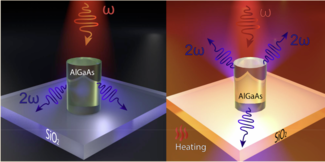Dielectric thermonanophotonics

Optical heating of nanostructures has applications in a number of fields related to chemistry, biology and medicine: for thermal control of chemical reactions, targeted drug delivery, photothermal imaging of biological objects, etc.
Semiconductor and dielectric materials can have large thermo-optic coefficients, which allows observing optical nonlinear effects associated with heating of resonant nanostructures. In addition, in semiconductor materials, the ohmic losses responsible for optical heating can vary over a wide range. These factors, well studied in bulk materials, strongly modify the properties of nonmetallic subwavelength resonators and allow effective control of the parameters of meta-atoms and metasurfaces, such as tuning the directional pattern of a nonlinear signal. The conditions of the most effective heating require a self-consistent problem, which makes their study a non-trivial and interesting issue, and leads to interesting modes of operation, so for example, the bistability mode can be achieved.
Staff





